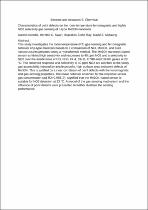 ResearchSpace
ResearchSpace
Characteristics of point defects on the room temperature ferromagnetic and highly NO2 selectivity gas sensing of p-type Mn3O4 nanorods
JavaScript is disabled for your browser. Some features of this site may not work without it.
- ResearchSpace
- →
- Research Publications/Outputs
- →
- Journal Articles
- →
- View Item
| dc.contributor.author |
Kortidis, Ioannis

|
|
| dc.contributor.author |
Swart, HC

|
|
| dc.contributor.author |
Ray, Suprakas S

|
|
| dc.contributor.author |
Motaung, David E

|
|
| dc.date.accessioned | 2019-07-23T11:42:13Z | |
| dc.date.available | 2019-07-23T11:42:13Z | |
| dc.date.issued | 2019-04 | |
| dc.identifier.citation | Kortidis, I., Swart, H.C., Ray, S.S, and Motaung, D.E. 2019. Characteristics of point defects on the room temperature ferromagnetic and highly NO2 selectivity gas sensing of p-type Mn3O4 nanorods. Sensors and Actuators B: Chemical | en_US |
| dc.identifier.issn | 0925-4005 | |
| dc.identifier.uri | https://www.sciencedirect.com/science/article/pii/S0925400519300267 | |
| dc.identifier.uri | https://doi.org/10.1016/j.snb.2019.01.007 | |
| dc.identifier.uri | http://hdl.handle.net/10204/11037 | |
| dc.description | Copyright: 2019 Elsevier. Due to copyright restrictions, the attached PDF file only contains the abstract of the full text item. For access to the full text item, kindly consult the publisher's website | en_US |
| dc.description.abstract | This study investigates the room temperature (RT) gas-sensing and ferromagnetic behavior of p-type materials based on a comparison of NiO, Mn3O4, and CuO nanostructures prepared using a hydrothermal method. The Mn3O4 nanorods based sensor exhibited high sensitivity and responses to 40 ppm NO2 and a selectivity to NO2 over the interference of CO, NH3, CH4, C6H6, C7H8 and C3H6O gases at 23 °C. The observed response and selectivity to 40 ppm NO2 are ascribed to the vastly gas accessibility induced by ample porosity, high surface area and point defects of Mn3O4. This is justified by a clear correlation of point defects with the ferromagnetic and gas-sensing properties. The linear behavior observed for the response versus gas concentration (adj R2=0.98519), signified that the Mn3O4-based sensor is suitable for NO2 detection at 23 °C. A model of the gas-sensing mechanism and the influence of point defects were presented to further illustrate the sensing performance. | en_US |
| dc.language.iso | en | en_US |
| dc.publisher | Elsevier | en_US |
| dc.relation.ispartofseries | Worklist;22477 | |
| dc.subject | Mn3O4 | en_US |
| dc.subject | p-type materials | en_US |
| dc.subject | Ferromagnetism | en_US |
| dc.subject | Gas sensing | en_US |
| dc.title | Characteristics of point defects on the room temperature ferromagnetic and highly NO2 selectivity gas sensing of p-type Mn3O4 nanorods | en_US |
| dc.type | Article | en_US |
| dc.identifier.apacitation | Kortidis, I., Swart, H., Ray, S. S., & Motaung, D. E. (2019). Characteristics of point defects on the room temperature ferromagnetic and highly NO2 selectivity gas sensing of p-type Mn3O4 nanorods. http://hdl.handle.net/10204/11037 | en_ZA |
| dc.identifier.chicagocitation | Kortidis, Ioannis, HC Swart, Suprakas S Ray, and David E Motaung "Characteristics of point defects on the room temperature ferromagnetic and highly NO2 selectivity gas sensing of p-type Mn3O4 nanorods." (2019) http://hdl.handle.net/10204/11037 | en_ZA |
| dc.identifier.vancouvercitation | Kortidis I, Swart H, Ray SS, Motaung DE. Characteristics of point defects on the room temperature ferromagnetic and highly NO2 selectivity gas sensing of p-type Mn3O4 nanorods. 2019; http://hdl.handle.net/10204/11037. | en_ZA |
| dc.identifier.ris | TY - Article AU - Kortidis, Ioannis AU - Swart, HC AU - Ray, Suprakas S AU - Motaung, David E AB - This study investigates the room temperature (RT) gas-sensing and ferromagnetic behavior of p-type materials based on a comparison of NiO, Mn3O4, and CuO nanostructures prepared using a hydrothermal method. The Mn3O4 nanorods based sensor exhibited high sensitivity and responses to 40 ppm NO2 and a selectivity to NO2 over the interference of CO, NH3, CH4, C6H6, C7H8 and C3H6O gases at 23 °C. The observed response and selectivity to 40 ppm NO2 are ascribed to the vastly gas accessibility induced by ample porosity, high surface area and point defects of Mn3O4. This is justified by a clear correlation of point defects with the ferromagnetic and gas-sensing properties. The linear behavior observed for the response versus gas concentration (adj R2=0.98519), signified that the Mn3O4-based sensor is suitable for NO2 detection at 23 °C. A model of the gas-sensing mechanism and the influence of point defects were presented to further illustrate the sensing performance. DA - 2019-04 DB - ResearchSpace DP - CSIR KW - Mn3O4 KW - p-type materials KW - Ferromagnetism KW - Gas sensing LK - https://researchspace.csir.co.za PY - 2019 SM - 0925-4005 T1 - Characteristics of point defects on the room temperature ferromagnetic and highly NO2 selectivity gas sensing of p-type Mn3O4 nanorods TI - Characteristics of point defects on the room temperature ferromagnetic and highly NO2 selectivity gas sensing of p-type Mn3O4 nanorods UR - http://hdl.handle.net/10204/11037 ER - | en_ZA |





